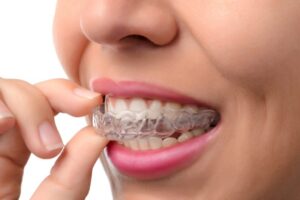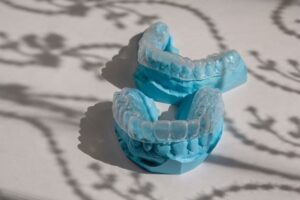The National Institute of Dental and Craniofacial Research estimates that as many as 10 million Americans suffer from TMJ disorders. TMJ disorder is a complex problem that negatively influences the jaw and causes a ripple effect throughout the body. Although the best way to address TMJ disorder varies from person to person, Invisalign’s® powerful, clear aligner system has been able to correct TMJ issues in some instances.
Dr. Mina Levi is proud to provide Invisalign® and other services to mitigate TMJ discomfort. If you’re struggling with chronic jaw pain? California Dental Innovations can help. Contact our San Francisco office today.
Before starting orthodontic treatment for TMJ pain, it’s essential to understand how your dental alignment impacts your jaw health.
TMJ and TMD Defined
A common misconception is that TMJ and TMD are the same things. However, they are two separate medical terms:
- TMJ refers to the “temporomandibular joint.” The TMJ is a delicate, hinge-like joint. It’s next to both ears and connects your jaw to your skull. Although the TMJ is delicate, we put it to good use. Daily, we use our TMJ to open and close our mouths for chewing, speaking, and laughing.
- TMD stands for “temporomandibular joint disorder.” TMD is an umbrella term for an array of issues that adversely affect the temporomandibular joint.
In short, the TMJ is the joint, and the TMD is the condition.
Signs of TMD
Symptoms and severity of TMJ disorders vary from person to person. Some patients report:
- Jaw popping, locking, or clicking when opening or closing the mouth
- Struggling to open and close the mouth
- Soreness and tenderness in the jaw
- Worn-down teeth
- Frequent headaches, migraines, and neckaches
- Ringing or pain in the ear and areas around it
- Vertigo
Misalignment and TMJ Disorder
TMD is not a one-size-fits-all health problem. TMD can have many causes for some, and sometimes, there’s no evident cause. Still, a misaligned bite can be to blame for TMJ problems.
Both rows of teeth should rest comfortably together when you close your mouth. However, your jaw can overcompensate for misalignment and cause strain if your jaws do not meet correctly. This extra stress can cause your jaw and surrounding muscles to become sore.
Correcting Misalignment with Invisalign®
Initially, Invisalign® was marketed primarily as a cosmetic dentistry treatment, and Align Technology has made great strides since the original model. Now, Invisalign® can straighten underbites, overbites, crossbites, and open bites. Furthermore, Invisalign® can tackle more complex cases using attachments and other accessories designed to encourage the jaw to rest in the correct position while straightening the teeth.
Orthodontics is an effective treatment option for TMD if the cause of your discomfort is misalignment. Realigning the bite can potentially reduce or eliminate ongoing TMD symptoms. But, it’s essential to confirm that orthodontic treatment is needed. Starting unnecessary orthodontic treatment can cause or worsen TMD, so speak with a professional before starting any orthodontic treatment.
Start TMJ Treatment in San Francisco
Invisalign® can do more than straighten your teeth—it might also be able to address annoying TMJ discomfort. If you’re curious about whether clear aligner therapy may be able to provide sweet relief, Dr. Mina Levi is eager to consult with you. Schedule your initial consultation for Invisalign® in San Francisco by calling 415-513-5066 or messaging us online.










